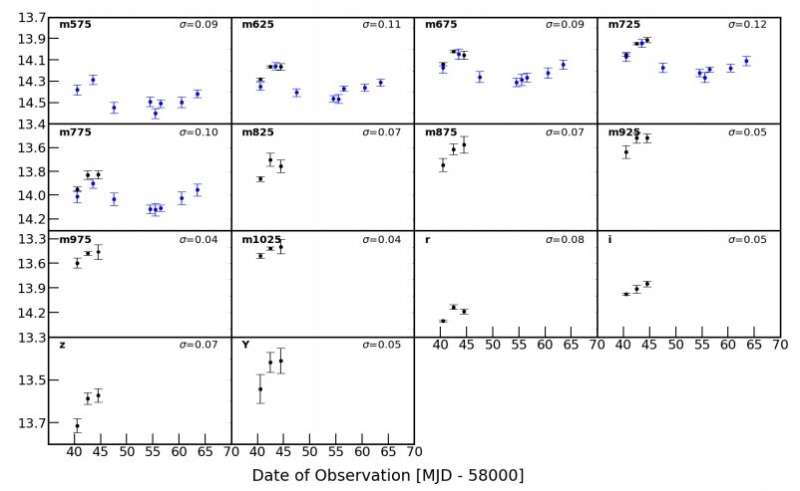Light curves of TXS 0506+056 using different filters. The blue points are the WIT data and the black points are those from SQUEAN. It shows the mild variabilities in the filters m575 through m775. The filter name is shown in the upper left corner and the excess variability is shown in the upper right corner in each plot. Credit: Hwang et al., 2020.
Astronomers have performed spectroscopic observations of a neutrino-emitting blazar known as TXS 0506+056. Results of this observational campaign, presented in a paper published November 28 on the arXiv pre-print server, shed more light on the nature of this mysterious object.
Blazars, classified as members of a larger group of active galaxies that host active galactic nuclei (AGN), are the most numerous extragalactic gamma-ray sources. Their characteristic features are relativistic jets pointed almost exactly toward the Earth. In general, blazars are perceived by astronomers as high-energy engines serving as natural laboratories to study particle acceleration, relativistic plasma processes, magnetic field dynamics and black hole physics.
Based on their optical emission properties, astronomers divide blazars into two classes: flat-spectrum radio quasars (FSRQs) that feature prominent and broad optical emission lines, and BL Lacertae objects (BL Lacs), which do not.
At a redshift of 0.336, TXS 0506+056 is a blazar recently identified as the counterpart of the neutrino event designated IceCube-170922A. Some observations show that TXS 0506+056 is a BL Lac object from the spectral classification point of view, while the other studies suggest that this blazar is only masquerading as a BL Lac with properties in line with FSRQs.
In order to get more insights into the nature of TXS 0506+056, a team of astronomers led by Sungyong Hwang of the Seoul National University, South Korea, conducted low-resolution spectroscopic observations of this blazar. For this purpose, they used the SED (spectral energy distribution) Camera for Quasars in Early Universe (SQUEAN) of the 82-inch Otto Struve telescope and the Wide-field Integral-Field Unit (IFU) Telescope (WIT), both at the McDonald Observatory.
"As an attempt to understand the nature of TXS 0506+056, we report the medium-band observation results of TXS 0506+056, covering the wavelength range of 0.575 to 1.025 µm," the astronomers wrote in the paper.
The study shows that TXS 0506+056 is somewhat variable during the observed period, exhibiting a decrease in flux, and then increase in flux again. The results suggest that the blazar has an inter-day variability at a level of 0.1 mag during the monitoring campaign. In general, the source was found to be variable in short-term, but the variability appears to be rather achromatic during the same period.
By comparing the new observations to previous results, the researchers found that TXS 0506+056 is not an outlier from the blazar sequence. Moreover, the blazar seems to showcase the redder-when-brighter nature, which indicates the FSRQ type. However, more extensive study using a larger set of data is required to confirm this assumption.
In concluding remarks, the authors of the paper noted that the study demonstrates how spectroscopic observations with small and medium-sized telescopes can be helpful in investigating spectral variability of astrophysical objects such as neutrino sources.
More information: Medium-band observation of the neutrino emitting blazar, TXS 0506+056, arXiv:2011.14049 [astro-ph.HE] arxiv.org/abs/2011.14049
© 2020 Science X Network
























